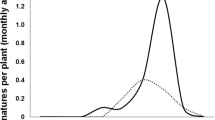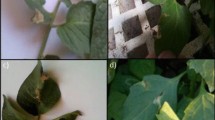Abstract
Nesidiocoris tenuis (Hemiptera: Miridae) is an important biocontrol agent of several key arthropod pests, including the South American tomato pinworm, Tuta absoluta (Lepidoptera: Gelechiidae). However, it can cause economic damage owing to its herbivory. Risk assessment on plant for the predator under different temperature thresholds is necessary for managing its phytophagy in tomato cultivation. We investigated the predator plant damage and its development under the influence of temperature and tomato variety. Ten commercial tomato varieties of different types (round red, small cherry, date baby plum, piccadilly plum and marmande beefsteak) were tested in the laboratory under five constant temperatures (15, 20, 25, 30 and 35 °C). The amount of fourth-instar nymphs moulted into adults and stem necrotic rings induced by the feeding activity was evaluated. The plant damage differed among the varieties and increased significantly across the temperatures up to 30 °C, with a slight decline at 35 °C. Temperature and variety significantly affected the nymphal development with an increasing number of moulted adults at increasing temperature, but with slight differences among tomato varieties. Our findings provide valuable information on the mirid response to the tested abiotic and biotic factors, which can help in the management and exploitation of N. tenuis as a biocontrol agent in tomato crop.


Similar content being viewed by others
References
Arnó J, Castañé C, Riudavets J, Roig J, Gabarra R (2006) Characterization of damage to tomato plants produced by the zoophytophagous predator Nesidiocoris tenuis. IOBC WPRS Bull 29:249–254
Arnó J, Castane C, Riudavets J, Gabarra R (2010) Risk of damage to tomato crops by the generalist zoophytophagous predator Nesidiocoris tenuis (Reuter) (Hemiptera: Miridae). Bull Entomol Res 100:105–115
Biondi A, Zappalà L, Di Mauro A, Tropea Garzia G, Russo A, Desneux N, Siscaro G (2016) Can alternative host plant and prey affect phytophagy and biological control by the zoophytophagous mirid Nesidiocoris tenuis? Biocontrol 61:79–90
Biondi A, Guedes RNC, Wan FH, Desneux N (2018) Ecology, worldwide spread, and management of the invasive south American tomato pinworm, Tuta absoluta: past, present, and future. Annu Rev Entomol 63:239–258
Bouagga S, Urbaneja A, Rambla JL, Flors V, Granell A, Jaques JA, Pérez-Hedo M (2018) Zoophytophagous mirids provide pest control by inducing direct defences, antixenosis and attraction to parasitoids in sweet pepper plants. Pest Manag Sci 74:1286–1296
Cabello T, Gallero JR, Fernandez FJ, Gamez M, Vila E, Del Pino M, Hernández-Suárez E (2012) Biological control strategies for the South American tomato moth (Lepidoptera: Gelechiidae) in greenhouse tomatoes. J Econ Entomol 105:2085–2096
Calvo FJ, Bolckmans K, Belda JE (2012) Release rate for a pre-plant application of Nesidiocoris tenuis for Bemisia tabaci control in tomato. Biocontrol 57:809–817
Campos MR, Biondi A, Adiga A, Guedes RNC, Desneux N (2017) From the Western Palaearctic region to beyond: Tuta absoluta ten years after invading Europe. J Pest Sci 90:787–796
Castañé C, Arnó J, Gabarra R, Alomar O (2011) Plant damage to vegetable crops by zoophytophagous mirid predators. Biol Control 59:22–29
De Puysseleyr V, De Man S, Höfte M, De Clercq P (2013) Plantless rearing of the zoophytophagous bug Nesidiocoris tenuis. Biocontrol 58:205–213
Desneux N, Wajnberg E, Wyckhuys KAG, Burgio G, Arpaia S et al (2010) Biological invasion of European tomato crops by Tuta absoluta: ecology, geographic expansion and prospects for biological control. J Pest Sci 83:197–215
Guedes RNC, Roditakis E, Campos MR, Haddi K, Bielza P et al (2019) Insecticide resistance in the tomato pinworm Tuta absoluta: patterns, spread, mechanisms, management and outlook. J Pest Sci. https://doi.org/10.1007/s10340-019-01086-9
Hughes GE, Bale JS, Sterk G (2009) Thermal biology and establishment potential in temperate climates of the predatory mirid Nesidiocoris tenuis. Biocontrol 54:785–795
Ingegno BL, Pansa MG, Tavella L (2011) Plant preference in the zoophytophagous generalist predator Macrolophus pygmaeus (Heteroptera: Miridae). Biol Control 58:174–181
Ingegno BL, Ferracini C, Gallinotti D, Alma A, Tavella L (2013) Evaluation of the effectiveness of Dicyphus errans (Wolff) as predator of Tuta absoluta (Meyrick). Biol Control 67:246–252
Lykouressis D, Perdikis D, Michalaki M (2001) Nymphal development and survival of Macrolophus pygmaeus Rambur (Hemiptera: Miridae) on two eggplant varieties as affected by temperature and presence/absence of prey. Biol Control 20:222–227
Mansour R, Brévault T, Chailleux A, Cherif A, Grissa-Lebdi K et al (2018) Occurrence, biology, natural enemies and management of Tuta absoluta in Africa. Entomol Gen 38:83–112
Martínez-García H, Román-Fernández LR, Sáenz-Romo MG, Péreze-Moreno I, Marco-Mancebòn VS (2015) Optimizing Nesidiocoris tenuis (Hemiptera: Miradae) as a biological control agent: mathematical models for predicting its development as a function of temperature. Bull Entomol Res 106:215–224
Messelink GJ, Bloemhard CMJ, Hoogerbrugge H, Van Schelt J, Ingegno BL, Tavella L (2015) Evaluation of mirid predatory bugs and release strategy for aphid control in sweet pepper. J Appl Entomol 139:333–341
Mollá O, González-Cabrera J, Urbaneja A (2011) The combined use of Bacillus thuringiensis and Nesidiocoris tenuis against the tomato borer Tuta absoluta. Biocontrol 56:883–891
Mollá O, Biondi A, Alonso-Valiente M, Urbaneja A (2014) A comparative life history study of two mirid bugs preying on Tuta absoluta and Ephestia kuehniella eggs on tomato crops: implications for biological control. Biocontrol 59:175–183
Naselli M, Urbaneja A, Siscaro G, Jaques J, Zappalà L, Flors V, Pérez-Hedo M (2016) Stage-related defense response induction in tomato plants by Nesidiocoris tenuis. Int J Mol Sci 17:1210
Pazyuk IM, Musolin DL, Reznik SY (2013) Geographic variation in thermal and photoperiodic effects on development of zoophytophagous plant bug Nesidiocoris tenuis. J Appl Entomol 138:36–44
Perdikis D, Arvaniti K (2016) Nymphal development on plant vs. leaf with and without prey for two omnivorous predators: Nesidiocoris tenuis (Reuter, 1895) (Hemiptera: Miridae) and Dicyphus errans (Wolff, 1804) (Hemiptera: Miridae). Entomol Gen 35:297–306
Perdikis D, Fantinou A, Garantonakis N, Kitsis P, Maselou D, Panagakis S (2009) Studies on the damage potential of the predator Nesidiocoris tenuis on tomato plants. Bull Insectol 62:41–46
Pérez-Hedo M, Urbaneja A (2015) The zoophytophagous predator Nesidiocoris tenuis: a successful but controversial biocontrol agent in tomato crops. In: Horowitz AR, Ishaaya I (eds) Advances in insect control and resistance management. Springer, Dordrecht, pp 121–138
Pérez-Hedo M, Bouagga S, Jaques JA, Flors V, Urbaneja A (2015a) Tomato plant responses to feeding behaviour of three zoophytophagous predators (Hemiptera: Miridae). Biol Control 86:46–51
Pérez-Hedo M, Urbaneja-Bernat P, Jaques JA, Flors V, Urbaneja A (2015b) Defensive plant responses induced by Nesidiocoris tenuis (Hemiptera: Miridae) on tomato plants. J Pest Sci 88:543–554
Puentes A, Stephan JG, Björkman C (2018) A systematic review on the effects of plant-feeding by omnivorous arthropods: time to catch-up with the mirid-tomato bias? Front Ecol Evol 6:218
Sánchez JA (2008) Zoophytophagy in the plantbug Nesidiocoris tenuis. Agric For Entomol 10:75–80
Sánchez JA (2009) Density thresholds for Nesidiocoris tenuis (Heteroptera: Miridae) in tomato crops. Biol Control 51:493–498
Sánchez JA, Lacasa A (2008) Impact of the zoophytophagous plant bug Nesidiocoris tenuis (Hemiptera: Miridae) on tomato yield. J Econ Entomol 101:1864–1870
Sánchez JA, del Pino-Perez M, Davò MM, Martinez-Cascales JI, Lacasa A (2006) Zoophytophagy of the plantbug Nesidiocoris tenuis in tomato crops in southeast Spain. IOBC WPRS Bull 29:243–248
Sánchez JA, Lacasa A, Arnó J, Castañé C, Alomar O (2009) Life history parameters for Nesidiocoris tenuis (Reuter) (Het. Miridae) under different temperature regimes. J Appl Entomol 133:125–132
Sankarganesh E, Firake D, Sharma B, Verma V, Behere G (2017) Invasion of the South American Tomato Pinworm, Tuta absoluta, in northeastern India: a new challenge and biosecurity concerns. Entomol Gen 36:335–345
Shaltiel-Harpaz L, Gerling D, Graph S, Kedoshim H, Azolay L et al (2016) Control of the tomato leafminer, Tuta absoluta (Lepidoptera: Gelechiidae), in open-field tomatoes by indigenous natural enemies occurring in Israel. J Econ Entomol 109:120–131
Urbaneja A, Tapia G, Stansly P (2005) Influence of host plant and prey availability on developmental time and survivorship of Nesidiooris tenuis (Het.: Miridae). Biocontrol Sci Technol 15:513–518
Urbaneja A, Montón H, Mollá O (2009) Suitability of the tomato borer Tuta absoluta as prey for Macrolophus caliginosus and Nesidiocoris tenuis. J Appl Entomol 133:292–296
Vacante V, Tropea Garzia G (1994) Nesidiocoris tenuis: antagonista naturale di aleurodidi. Informatore Fitopatologico 4:23–28
Wheeler AG Jr (2000) Predacious plant bugs (Miridae). In: Schaefer CW, Panizzi AR (eds) Heteroptera of economic importance. CRC Press, Boca Raton, pp 657–693
Zappalà L, Biondi A, Alma A, Al-Jboory IJ, Arnó J et al (2013) Natural enemies of the South American moth, Tuta absoluta, in Europe, North Africa and Middle East, and their potential use in pest control strategies. J Pest Sci 86:635–647
Ziaei Madbouni MA, Samih MA, Namvar P, Biondi A (2017) Temperature-dependent functional response of Nesidiocoris tenuis Reuter (Hemiptera: Miridae) to different densities of pupae of cotton whitefly, Bemisia tabaci (Gennadius) (Hemiptera: Aleyrodidae). Eur J Entomol 114:325–331
Acknowledgements
This research was supported by the Italian Ministry of Education, University and Research (MIUR) (PRIN Project 2015 ‘BIOPIC’, 2015BABFCF), by the University of Catania (Project Emergent Pests and Pathogens and Relative Sustainable Strategies—5A722192113; PhD fellowship to MR) and through the ERA-NET action ARIMNET2 2015 call (project Sustainable Tomato Production—STomP).
Author information
Authors and Affiliations
Corresponding author
Ethics declarations
Conflict of interest
The authors declare that they have no conflict of interest.
Ethical approval
This article does not contain any studies with human participants or animals performed by any of the authors.
Additional information
Communicated by N. Desneux.
Publisher's Note
Springer Nature remains neutral with regard to jurisdictional claims in published maps and institutional affiliations.
Rights and permissions
About this article
Cite this article
Siscaro, G., Lo Pumo, C., Tropea Garzia, G. et al. Temperature and tomato variety influence the development and the plant damage induced by the zoophytophagous mirid bug Nesidiocoris tenuis. J Pest Sci 92, 1049–1056 (2019). https://doi.org/10.1007/s10340-019-01096-7
Received:
Revised:
Accepted:
Published:
Issue Date:
DOI: https://doi.org/10.1007/s10340-019-01096-7




